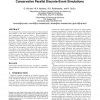Free Online Productivity Tools
i2Speak
i2Symbol
i2OCR
iTex2Img
iWeb2Print
iWeb2Shot
i2Type
iPdf2Split
iPdf2Merge
i2Bopomofo
i2Arabic
i2Style
i2Image
i2PDF
iLatex2Rtf
Sci2ools
82
Voted
SAC
2002
ACM
2002
ACM
Statistical properties of the simulated time horizon in conservative parallel discrete-event simulations
We investigate the universal characteristics of the simulated time horizon of the basic conservative parallel algorithm when implemented on regular lattices. This technique [1, 2] is generically applicable to various physical, biological, or chemical systems where the underlying dynamics is asynchronous. Employing direct simulations, and using standard tools and the concept of dynamic scaling from nonequilibrium surface/interface physics, we identify the universality class of the time horizon and determine its implications for the asymptotic scalability of the basic conservative scheme. Our main finding is that while the simulation converges to an asymptotic nonzero rate of progress, the statistical width of the time horizon diverges with the number of PEs in a power law fashion. This is in contrast with the findings of Ref. [3]. This information can be very useful, e.g., we utilize it to understand optimizing the size of a moving "time window" to enforce memory constraints....
Related Content
| Added | 23 Dec 2010 |
| Updated | 23 Dec 2010 |
| Type | Journal |
| Year | 2002 |
| Where | SAC |
| Authors | G. Korniss, M. A. Novotny, A. K. Kolakowska, H. Guclu |
Comments (0)

